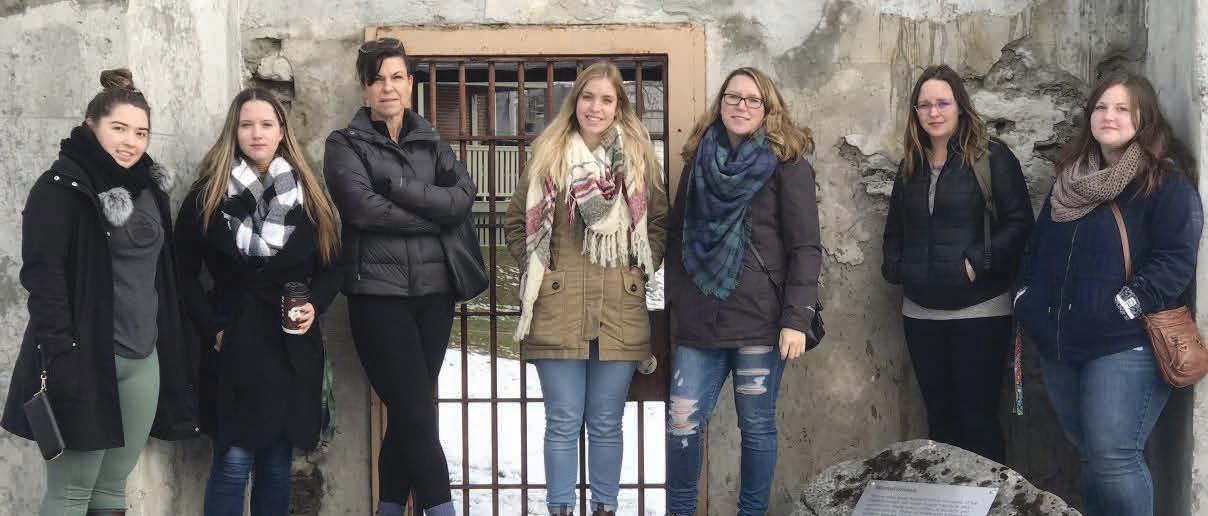
4 minute read
Spotlight on Research
As home to many of the world’s leading researchers, Trent University has countless stories to tell when it comes to research success. Through our outstanding researchers, world-class facilities, and prestigious schools of study, Trent is a place where ideas and creativity connect and intersect with industry, non-profits, communities and real-world solutions. Read more about some of the top faculty, student, and alumni researchers who are making headlines.
FACULTY

FACULTY RESEARCH SPOTLIGHT Going Beyond the Lecture Hall and Behind Bars
Trent Sociology professor Dr. Gillian Balfour and her students on their weekly visit to incarcerated people as part of the Critical Perspectives in Restorative Justice course
Paige Pascoe
“The most important experience in my university career.” These are the words expressed by a student who recently completed Trent’s “Critical Perspectives in Restorative Justice (WMST-4441H),” an innovative undergraduate course that takes experiential learning to the next level. Open to fourth-year Humanities and Social Sciences majors, the course offers students the unique chance to attend weekly classes held at a local correctional facility. Led by Trent Sociology professor Dr. Gillian Balfour as part of the national Walls to Bridges program, both university and incarcerated students collaborate to examine principles of social justice. By studying with prison inmates as peers rather than mentoring or helping them, Trent students confront their own stereotypical assumptions of incarcerated people, breaking down artificial boundaries between those on the inside versus the outside. “Our teachings challenge conventional educational models that rely on the professor as the ‘expert,’” explains Professor Balfour. “Instead, we view all students and instructors as both teachers and learners, valuing the knowledge inherent in the lived experiences of criminalization, imprisonment, poverty, abuse, racism and more.”
STUDENT RESEARCH SPOTLIGHT
Reading, Writing and Recess STUDENT
Is playtime more than just a bit of fun? According to new research conducted by undergraduate Psychology major Paige Pascoe, how much we play could also directly impact how well we do in school later on. Working with Trent Durham GTA professor Dr. Nancie Im-Bolter, the fourth-year Psychology student is exploring the possibility that the more preschool children play, the more advanced their reading and math skills are as they develop. Ms. Pascoe understands that the results from her research could influence how we raise our children.
“I feel as though it’s important to pursue this research because of the impact it could have on parents and caregivers,” she explains. “If play has an influential role in the development of children’s reading and math abilities, it would be a relatively easy solution for parents and educators to include more play in their existing interactions with children.”
ALUMNI RESEARCH SPOTLIGHT A Sticky Solution for Broken Bones

Having surgery to fix a broken bone is traumatic enough. Now imagine going under the knife a second time to remove the metal plate and screws from your body. This rigid hardware can be cumbersome for both doctor and patient alike, which is why two Trent Materials Science alumni have partnered to create a more “bio-friendly” solution. Co-founding their medical adhesives company Cohesys in 2018, CEO Michael Floros ’15 and COO Michael Tessier ’14, together with their team, are now set to launch their first product: BoneTape. Dubbed the “duct tape for bones,” their solution is a flexible, biodegradable tape engineered to replace more invasive metal procedures, specifically with craniomaxillofacial (oral, facial, skull, orbital) fractures. Inspired by adhesive proteins of marine organisms, BoneTape is the result of years of research. “The current surgical solutions were over-engineered and difficult to use,” explains Michael Floros. “Designing a new type of adhesive presents a number of mechanical and regulatory challenges, but our team has a wealth of scientific expertise and we’re excited to soon bring this device to market.” Bold research making a difference in the world. That’s the Trent University way. Read on for a sampling of the latest Trent research news featured at trentu.ca/news.
ALUMNI

Michael Floros and Michael Tessier at the launch event for the Prolong mug. Both were co-inventors on the product during their time studying at Trent.
MORE #TRENTURESEARCH HIGHLIGHTS
New Hope for Red Wolf Population Dr. Linda Rutledge ’05, assistant professor of Biology at Trent, was a key contributor to a recent study that may prove crucial to the survival of the critically endangered red wolf. Her latest research reveals the remarkable discovery that red wolf DNA was concealed in wild canines on Galveston Island off the U.S. Gulf Coast, a region where the species was deemed extinct nearly 40 years ago.
The Answer is Blowing in Trent’s Wind (Tunnel) When Eyjafjallajökull erupted, confusion ensued, and it wasn’t just among news anchors stumbling over their words as they struggled to pronounce the Icelandic volcano’s tricky name. With ash suspended above the north Atlantic, pilots’ vision was obscured, aircraft glass melted, and jet engines clogged. Dr. Cheryl McKenna-Neuman, a faculty member in the School of the Environment, is working to ensure this doesn’t happen again through her research to comprehend how aeolian transport is unique at more northerly latitudes.
An Innovative Approach to the Future of our Food By the year 2100, the population of Earth could top 11 billion. That’s nearly 50% more people than inhabit the planet today, meaning more mouths to feed than current agricultural techniques can produce food for. But food insecurity isn’t some problem of the semi-distant future that we can pass along to future generations—it’s already here. Nearly a billion people worldwide experience chronic food deprivation each year. Trent’s Alexandra Kuhne, a Master of Science student in the Environmental and Life Sciences graduate program, is taking an innovative approach to mitigating the harm that undernourishment causes.
Follow @TrentUniversity #TrentUResearch to read more research highlights and stories, and share your own #TrentU research stories.










